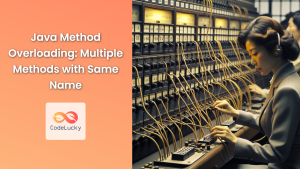Java 8 introduced a powerful feature called method references, which provide a concise way to refer to methods or constructors. These references act as shorthand notation for lambda expressions, making your code more readable and expressive. In this comprehensive guide, we'll dive deep into method references, exploring their various types and practical applications.
Understanding Method References
Method references are essentially compact lambda expressions for methods that already have a name. They allow you to refer to existing methods by name instead of invoking them directly. This feature is particularly useful when a lambda expression is doing nothing but calling an existing method.
The basic syntax for a method reference is:
ClassName::methodName
🔑 Key Point: Method references always use the double colon :: operator.
Types of Method References
Java supports four types of method references:
- Static method references
- Instance method references of a particular object
- Instance method references of an arbitrary object of a particular type
- Constructor references
Let's explore each type in detail with practical examples.
1. Static Method References
Static method references refer to static methods in a class. They're particularly useful when you have a static method that you want to use as a lambda expression.
📌 Example: Let's say we have a list of integers, and we want to print each number squared.
import java.util.Arrays;
import java.util.List;
public class StaticMethodReferenceExample {
public static void main(String[] args) {
List<Integer> numbers = Arrays.asList(1, 2, 3, 4, 5);
// Using lambda expression
numbers.forEach(n -> System.out.println(MathOperations.square(n)));
// Using static method reference
numbers.forEach(MathOperations::square);
}
}
class MathOperations {
public static int square(int n) {
return n * n;
}
}
In this example, MathOperations::square is a static method reference. It's equivalent to the lambda expression n -> MathOperations.square(n).
2. Instance Method References of a Particular Object
These method references refer to instance methods of a specific object.
📌 Example: Let's create a StringProcessor class with an instance method to process strings.
import java.util.Arrays;
import java.util.List;
public class InstanceMethodReferenceExample {
public static void main(String[] args) {
List<String> names = Arrays.asList("Alice", "Bob", "Charlie");
StringProcessor processor = new StringProcessor();
// Using lambda expression
names.forEach(name -> processor.processString(name));
// Using instance method reference
names.forEach(processor::processString);
}
}
class StringProcessor {
public void processString(String s) {
System.out.println("Processing: " + s.toUpperCase());
}
}
Here, processor::processString is an instance method reference of a particular object. It's equivalent to the lambda expression name -> processor.processString(name).
3. Instance Method References of an Arbitrary Object of a Particular Type
These method references refer to instance methods of an arbitrary object of a particular type. They're used when you want to call a method of an object that will be supplied as a parameter to the lambda expression.
📌 Example: Let's sort a list of strings based on their length.
import java.util.Arrays;
import java.util.List;
public class ArbitraryObjectMethodReferenceExample {
public static void main(String[] args) {
List<String> names = Arrays.asList("Alice", "Bob", "Charlie", "David");
// Using lambda expression
names.sort((s1, s2) -> s1.compareToIgnoreCase(s2));
// Using instance method reference of an arbitrary object
names.sort(String::compareToIgnoreCase);
System.out.println(names);
}
}
In this example, String::compareToIgnoreCase is an instance method reference of an arbitrary object of type String. It's equivalent to the lambda expression (s1, s2) -> s1.compareToIgnoreCase(s2).
4. Constructor References
Constructor references are used to create new instances of a class. They're particularly useful when working with functional interfaces that create objects.
📌 Example: Let's create a list of Person objects using constructor references.
import java.util.ArrayList;
import java.util.List;
import java.util.function.Function;
public class ConstructorReferenceExample {
public static void main(String[] args) {
List<String> names = List.of("Alice", "Bob", "Charlie");
// Using lambda expression
List<Person> people1 = createPeople(names, name -> new Person(name));
// Using constructor reference
List<Person> people2 = createPeople(names, Person::new);
people2.forEach(System.out::println);
}
public static List<Person> createPeople(List<String> names, Function<String, Person> constructor) {
List<Person> people = new ArrayList<>();
for (String name : names) {
people.add(constructor.apply(name));
}
return people;
}
}
class Person {
private String name;
public Person(String name) {
this.name = name;
}
@Override
public String toString() {
return "Person{name='" + name + "'}";
}
}
In this example, Person::new is a constructor reference. It's equivalent to the lambda expression name -> new Person(name).
Benefits of Using Method References
Method references offer several advantages:
-
Conciseness: They provide a more compact and readable syntax compared to lambda expressions.
-
Clarity: By referring to methods by name, they make the intention of the code clearer.
-
Reusability: They promote code reuse by allowing you to reference existing methods.
-
Performance: In some cases, method references can be more efficient than lambda expressions.
Method References vs Lambda Expressions
While method references are often more concise than lambda expressions, they're not always the best choice. Here are some guidelines:
- Use method references when the lambda expression is simply calling an existing method.
- Use lambda expressions when you need to perform additional operations or when the method doesn't exist yet.
📌 Example: Comparing method references and lambda expressions
import java.util.Arrays;
import java.util.List;
public class MethodReferenceVsLambdaExample {
public static void main(String[] args) {
List<Integer> numbers = Arrays.asList(1, 2, 3, 4, 5);
// Using method reference
numbers.forEach(System.out::println);
// Using lambda expression
numbers.forEach(n -> System.out.println("Number: " + n));
}
}
In this example, the method reference System.out::println is more concise for simple printing. However, the lambda expression allows for more complex operations, like adding a prefix to the output.
Advanced Use Cases
Method references can be used in more complex scenarios as well. Let's explore some advanced use cases.
Combining Method References with Streams
Method references work particularly well with Java streams, allowing for concise and expressive data processing.
📌 Example: Processing a list of employees
import java.util.Arrays;
import java.util.List;
import java.util.stream.Collectors;
public class MethodReferenceWithStreamsExample {
public static void main(String[] args) {
List<Employee> employees = Arrays.asList(
new Employee("Alice", 50000),
new Employee("Bob", 60000),
new Employee("Charlie", 55000)
);
// Using method references with streams
List<String> names = employees.stream()
.map(Employee::getName)
.collect(Collectors.toList());
double totalSalary = employees.stream()
.mapToDouble(Employee::getSalary)
.sum();
System.out.println("Employee names: " + names);
System.out.println("Total salary: " + totalSalary);
}
}
class Employee {
private String name;
private double salary;
public Employee(String name, double salary) {
this.name = name;
this.salary = salary;
}
public String getName() {
return name;
}
public double getSalary() {
return salary;
}
}
In this example, Employee::getName and Employee::getSalary are method references used within stream operations.
Method References in Functional Interfaces
Method references can be used wherever a functional interface is expected. This makes them versatile for use with Java's built-in functional interfaces like Predicate, Function, Consumer, etc.
📌 Example: Using method references with functional interfaces
import java.util.function.Predicate;
import java.util.function.Function;
import java.util.function.Consumer;
public class MethodReferenceWithFunctionalInterfacesExample {
public static void main(String[] args) {
// Predicate
Predicate<String> isEmpty = String::isEmpty;
System.out.println("Is empty: " + isEmpty.test(""));
// Function
Function<String, Integer> length = String::length;
System.out.println("Length: " + length.apply("Hello"));
// Consumer
Consumer<String> printer = System.out::println;
printer.accept("Hello, World!");
}
}
In this example, we use method references with different functional interfaces: String::isEmpty as a Predicate, String::length as a Function, and System.out::println as a Consumer.
Best Practices and Considerations
When using method references, keep these best practices in mind:
-
Readability: Use method references when they make your code more readable. If a lambda expression is clearer, use that instead.
-
Method Overloading: Be cautious with overloaded methods. The compiler might not be able to determine which overloaded method you're referring to.
-
Static Import: Consider using static imports to make your code even more concise when using static method references.
-
Performance: While method references can sometimes be more efficient, always profile your application to ensure you're getting the expected performance benefits.
-
Compatibility: Ensure that the method reference is compatible with the functional interface you're using it with.
Conclusion
Java method references are a powerful feature that can make your code more concise, readable, and expressive. By understanding the different types of method references and when to use them, you can write more elegant and maintainable Java code.
Remember, while method references are often a great choice, they're not always the best option. Always consider readability and the specific requirements of your code when deciding between method references and lambda expressions.
As you continue to work with Java, practice using method references in your projects. They're a valuable tool in any Java developer's toolkit, especially when working with functional programming concepts and the Streams API.
🚀 Happy coding, and may your Java code be ever more expressive and efficient with method references!



















